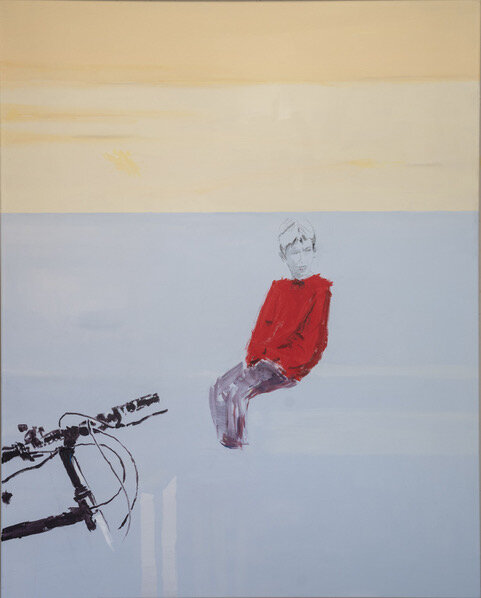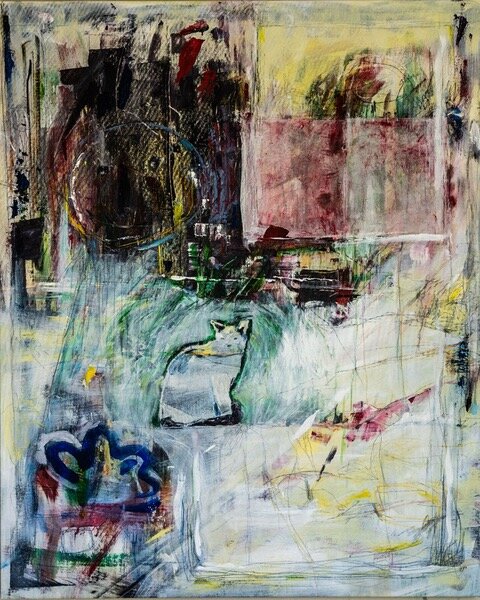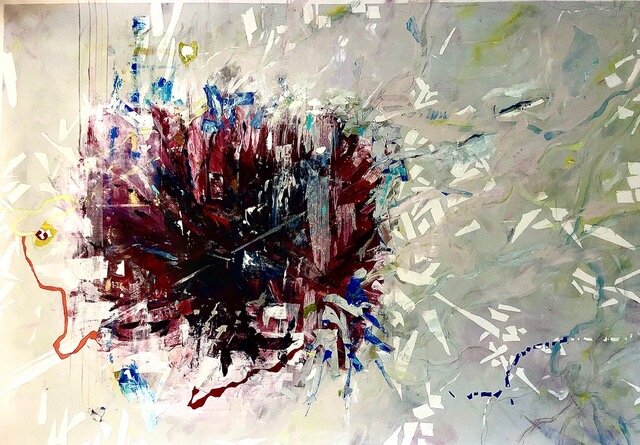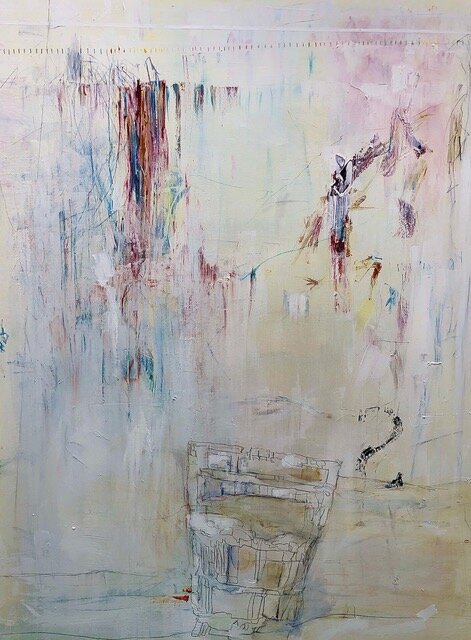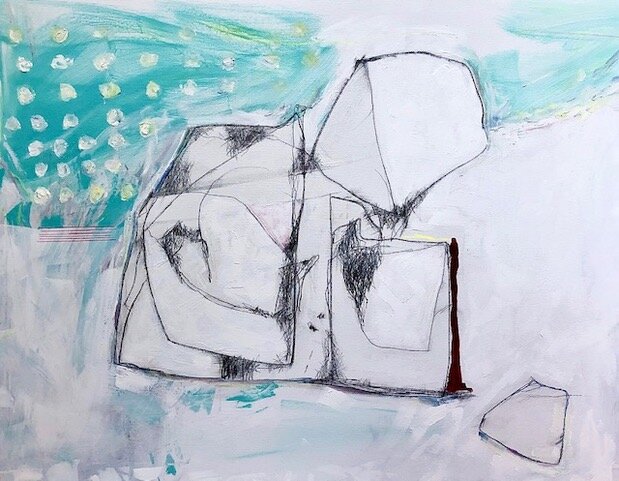Dalit Fresco
"What I'm trying to do is bring people closer to something, because an intimate world seems to me more human."
David Hockney.
Starting with a feeling, an image, a composition. The best result is when I’m surprised where it all ends, as if, like the author Etgar Keret described his process, you’re chasing a cat that ran out the window and you have no idea where it will lead you. Or if you ever going to dare again.
When I paint, I feel free of constrains, like leaving a big empty space undone, showing a child dangling without shoes, using the wrong colors, edges not perfectly straight.
I don’t seek resolution, conclusion, or justice. Rather, I'm drawn to the flawed, the imperfect, the mundane or unnoticed, the slightly awkward.
It is intuitive. It is liberating. And it is rewarding when someone responds to what I have created.
Red boy, 2018 Acrylic, pencil - 48x60
Don’t tell me, 2019 Acrylic, oil, pencil, pastel - 36x48
Gaza, 2017 mixed media - 60x48
Urgent still, 2019 Acrylic, pastel - 71x53
Contain your cat, 2020 Mixed media - 41x56
How to sleep, 2019 Acrylic, marker - 57x35
2020, 2020 Acrylic, marker - 30x40
My canceled plans, 2020 mixed media - 74x50
Untitled I, 2020 Acrylic, pencil, oil - 36x48
House in Ponta Delgada, 2020 Acrylic, pencil - 40x30
A place for everything, 2020 after Donald Judd’s “Untitled, 2019” Acrylic, pencil - 48x36
Why did you wait so long, 2020 Mixed media - 36x24
Equilibria, 2020 Acrylic, oil, pencil - 40x30
Untitled II, 2020 Mixed media - 48x36
Are we there yet, 2020 Mixed media - 36x48
Surrender: Front view, 2020 Acrylic, ink, oil - 36x48
You’re a new addition to the crayon box: Which color are you and why?
You know that silvery-gray-blue color of the early dawn? that one. It’s full of promise, hope and forgiveness.
How did you become interested in art?
Even though I used to paint as a child, as most of us do, it was only when I studied architecture that I was more seriously interested in art as something I can do and enjoy. I think the fact that it was a secondary pursuit allowed me to feel more free of conventions and norms, and simply express myself. Our school was in a building shared with a print house, and I would pick all kinds of left-over pieces of paper, and would draw, painted, in whatever medium was available. In fact, I was more fascinated with architects’ drawings and paintings, like Aldo Rossi, their lyrical side, rather than the structural and concrete.
What does your path to art look like?
The program in my Architecture school was heavily focused on art, very much in the tradition of the Bauhaus. Daily art classes, with great artists teachers, as well as emphasis on the process towards architecture, which involved drawings as an inherent part of any actual project.
Where do you find sources of inspiration?
Oh, inspiration. There’s a quote I like - “What makes you happy? Happiness makes me happy.”
I paint when I’m excited, when I’m full of hope, and also when I’m so sad I want to pour my tears on the canvas. I paint when I just want to play, when I give myself permission to do so. And then it’s the cross-section of all my geological layers.
Who are other artists that have influenced your work?
Each and every one. Every artist, every work of art, they’re all part of who I am and what I have in me. And by “artists” I mean painters, architects, poets, authors, fashion designers, musicians, and on and on. Many have resonated in various times, yet some have stayed dear throughout. Among the Israeli artists are Lea Nikel, Uri lifshitz, Yair Garbuz, Rachel Shavit. Some artists made a mark because of who they are, their approach to art, like Vancouver Island artist Sheila Norgate, who said - Make a mess! and, Use whatever you want to draw a perfect circle! and most importantly - Do not wait for permission.
Can you describe a real life experience that inspired one of your pieces?
Around 2017 Israel was engaged in another cycle of bombarding Gaza. I realized that a lot of people had no idea where Gaza was, what life was like there, or the severity and impact of these Israeli military actions on the city and its people. The painting “Gaza, 2017” was a very deliberate reaction to that. I googled “map of Ggaza”, and two things came up. One was a UN aerial map that showed, in red dots, all the damaged houses. The other was a virtual computer game, with the city of Gaza its virtual battleground. To me, that was indicative of the gap in comprehension of the reality in Gaza. In the painting, there are trees in that virtual city, but even they look like bullet holes. And the rosettes at the top are made in papier-mâché, signifying the long decay the city has endured. The blue strips in the middle are a sliver of what’s left from the vast mediterranean sea that is accessible to the people of Gaza.
What are three dominant themes present in your work?
For this I had to ask a friend, who said: “You walk, travel, both in time and in places, and you take us with you as you find things on your journey, be it a cup of coffee or a city map. There is a sense of longing, of placement between cultures. And there’s a discovery inside and outside.”
You’ve lived in Israel, England, and now California: How has living all around the world inspired your artwork?
Living and traveling to different countries has given me a perspective, a slightly better understanding about people, mostly. That despite countless differences, there is a commonality in aspirations, desires and basic needs.
What does a typical studio day look like for you?
I don’t paint on a regular daily basis. The process is ongoing, I am constantly in an “about-to-paint” mode, like a mother that is always aware of her child’s whereabouts. In the studio, I like to start by doing simple tasks, approach it like a menial work, prepare the canvas, or wood frame, mix colors, put on some music, trying to be as simple and empty of goals and fears as I can, I start by using a pencil, which gives me a sense of direct and physical contact with the frame. I paint, and leave, come back, sometimes from a different entrance, looking at it anew. I can go for days with a nagging feeling of how to proceed. And I know it’s done when I have that sense of peace, when nothing bothers me anymore.
Which superpower would you have, and why?
I sincerely feel I have all the powers I need. I could, though, use more appreciation and diligence in applying them.
What is your favorite tool to create with?
I love drawing with a simple pencil. It’s primal, and as close to having an extension of my hand. I had to learn to trust a paint brush… There’s one brush that is small and wide which feels good to hold. I do like using a knife for more assertive marks.
Do you have a favorite part of the artistic process?
At first, it was the completion. I used to feel relieved, as if I managed to survive. But now I have learned to love the whole process, the scary where-I’m-even-going, the doubts, the fight, the discovery, the sense of knowing, and the sheer wonder at the end. I sometimes look at a painting and have absolutely no recollection of having made those marks.
You write that you “start with a feeling” when beginning your work; can you talk about a feeling that inspired you to start creating a particular piece?
The painting “At the Altar, 2019” was made at a time of great personal pain. I felt like an instrument, the flute, that has the potential to be played, but is set broken into pieces in a box. I felt like kneeling in front of the canvas, in a prayer to be put together again. The vast almost-empty space was scary at first, but there was nothing for me to convey there but a prayer and a hope.
How has your practice changed over time?
I used to be concerned with the outcome. as my confidence grew, I allowed myself to be more patient, not to rush through. I believe in the in-betweens, when seemingly nothing is happening, that a great deal IS happening. And I also have more of that doubtful-yet-certain knowledge, which comes from plain experience, that I will be able to create once more.
How has quarantine changed your practice?
I actually found tremendous freedom and inspiration during the Covid quarantine. Maybe the notion that there is nowhere to go and not much to do has freed me to focus, with a calm feeling, of no haste, no deadlines, and a long stretch of time ahead. The only thing I missed was sharing with people, not just the excitement, but also getting feedback.
What is the best piece of advice you’ve been given?
Do not wait for permission.
I think that all artists doubt whether they are “allowed” to be, but it's more so true for women, as there’s always an invisible line that we hesitate to cross.
And also, “purple and orange are your best friends.”
If you could become one of your characters/works of art which one would you become, and why?
The “Bowl” painting (Urgent still, 2019) was very heart-felt and intimate in its creation. I wanted to have a vessel that could contain me in its physical size, that I could both hide and sail away in. I wanted something bigger than myself to carry me away from the dock I was tied to.
What is your favorite accomplishment thus far?
A painting of mine sold on my first group exhibition. There is something about the commitment one makes to a piece of art that is very rewarding.
What is your ultimate professional goal?
A solo exhibition. I want as many people as possible to see my work in real life and to be moved and excited and share their feelings with me.
Are there any current art world trends you’re following?
Living near Los Angeles I get to visit - well, until recently - great museums and art galleries with fantastic art.
There’s no substitute for experiencing art in real life.
Cocktails with the Curators - Dalit Fresco
In this episode Vanessa and Liz make a Classic Champaign Cocktail and talk about Dalit Fresco's piece Surrender

